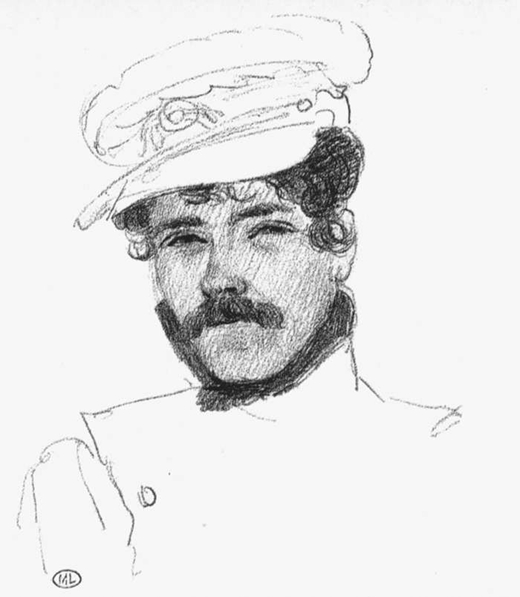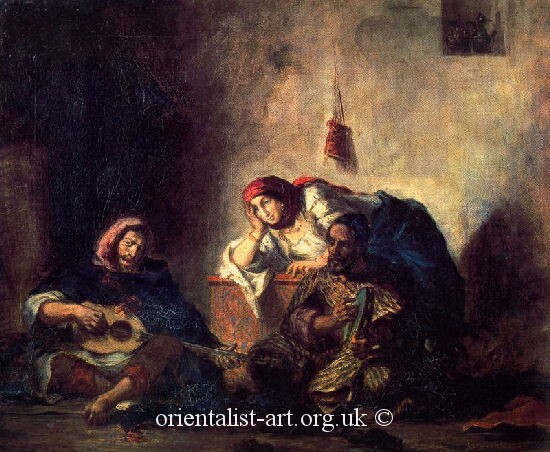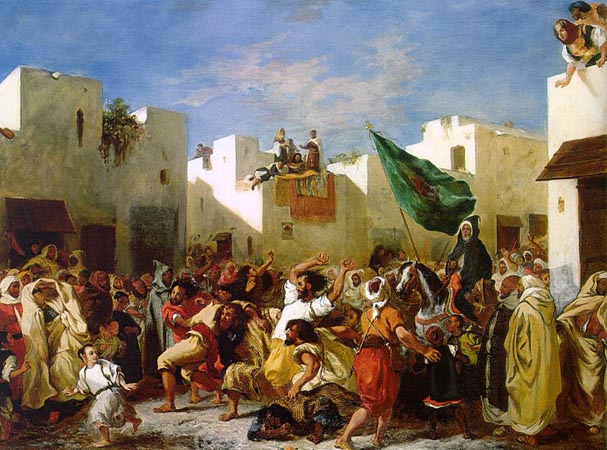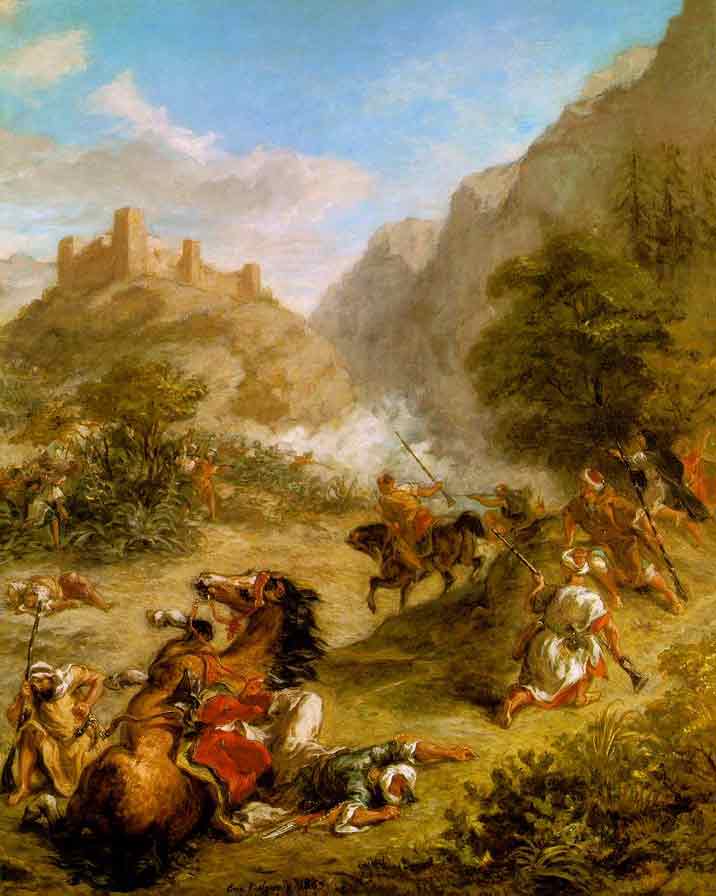THE POWER OF GAZE
Creating means revealing the ultimate duality. The duality of art itself. As Gilles Deleuze said, ” Aesthetics suffer from harrowing duality. It designates the theory of sensibility, on the one hand, as a form of possible experience; on the other, it designates the theory of art as a reflection of real experience. For the two meanings to come together it is necessary that the conditions of experience in general should themselves become conditions of real experience; the work of art then seems like experimentation.”( Logique du Sens )
Eugene Delacroix’s trip to Africa in the Charles de Mornay diplomatic expedition in 1832 resulted in Delacroix contributing a new voice to the discourse of art since it combined his first real experience outside France and a confrontation with the violent physical sensations of Morocco synthesized with his artistic experimentation. He succeeded is transforming his work from superficial, yet gifted salon painter into creating a singular aesthetic that would be intelligible to many. It was a proposition that contradicted monotony and showed insightful, rather than a cursive view of the universally human. Hannah Arendt reminds us of the risk of this operation and the price to be paid,” It seems that a man who is simply a man has lost precisely those qualities that make it possible for others to treat him as fellow human”.( L’imperialisme, 1983 )
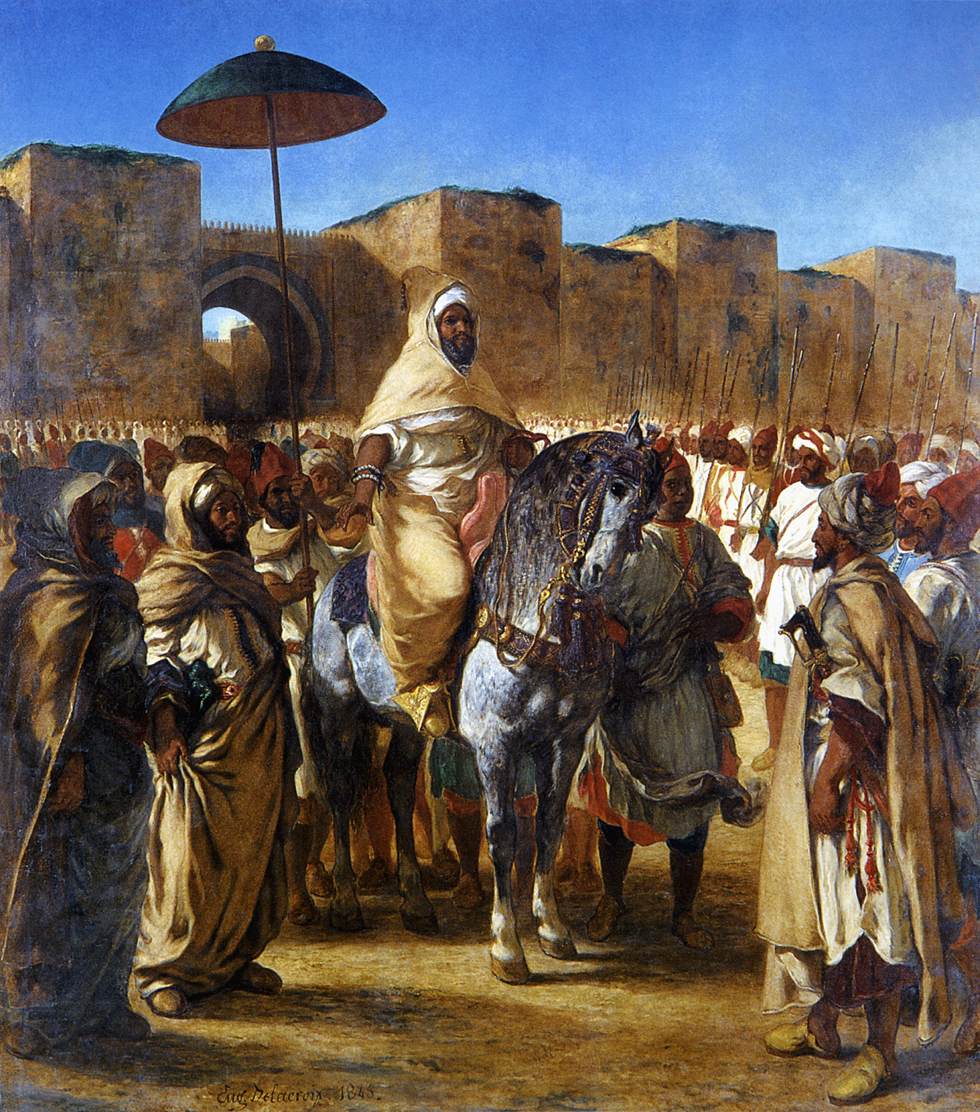
Delacroix, The Sultan of Morocco Surrounded By His Court.A classical arrangement of verticals and horizontals. The purely literary romanticism is somewhat muted but far from lost. Painting completed 1845.
Delacroix was certainly not ordinary. He was one of the most articulate and generally intelligent painters on record. Still, it is true that up to this point he had shown a distaste for ordinary reality and for what many people would call sincerity. He had a frail body, and was somewhat of an effete aristocrat, far removed from the swill of the urban poor in Paris. In sum, he had been living and creating largely on the basis of secondary sources and feigned feelings, though his dedication to the craft of painting is without reproach.
In a letter he wrote from the imperial city of Meknes, Delacroix wonders ironically about the wisdom of ever returning to France in a letter to Pierret; ” What new revolutions are you preparing for us with your ragpickers and your Carlists and your crossroads Robespierre’s? Tempora! Is this the price one pays for civilization and the bliss of having a round hat instead of a burnoose?”
The costume and dignity of the Moroccans furnished him occasions for continuing at long distance his war with the neoclassical and academic followers of Jacques Louis David.In one letter he remarks, ”The heroes of David and company with their rose colored members would cut a sorry figure alongside these sons of the sun…” Referring to the Paris custom of sending young painters to study at the French Academy in Rome, he says it would be better for them, ”to be sent as cabin boys on the first ship for Barbary”.
The trip for Delacroix was transformative. He had been enclosed in an archetype of privileged aristocratic profiter of the Revolution, yet there was an endogenous image seeking to catalyze itself, to express what Delacroix called the ”chaotic world of sensations” in using art as a language to translate that world, those sensations, into the reality of a visible representation; to mold and shape chaos into a balanced, organized whole.
For Delacroix, this involved a deconstruction of images that previously prevailed such as questioning the political and colonial model that until then, had been set up as absolute truth. Delacroix’s Moroccan experience remained vivid in the artist’s imagination until his death. It may be regarded historically as a prelude to the impressionists’ move outdoors, which finally wrecked the archaic academic system. Most of these Moroccan paintings, though perhaps recalling some of the vibrating brushwork of Constable; are informed by a sensibility hit by an awareness of color as a study in itself and color as a legitimate material for composition.
The change was remarked upon immediately. When ”Woman of Algiers” was exhibited at the Paris Salon of 1834, the critic Gustave Planche wrote, ”this capital piece … marks a grave moment in the life of Monsieur Delacroix…The color is brilliant and pure everywhere, but without ever being crude…It is painting and nothing else, painting that is frank, vigorous, vividly accented, with a boldness that is thoroughly Venetian and yet owes nothing to the masters of whom it reminds you”
One of the ultimate results of the dream trip to North Africa seems to have been a taming or mastery of the more flamboyant and romantic impulses in Delacroix. A coming to terms with a previous distaste for reality as he departed perceptibly, though never entirely from purely literary inspiration. He employed a richer palette, but at the same time a more sober one; gone were the excesses of ”The Death of Sardanapalus” and ”Liberty Leading the People (1830), which were rhetorical and political fantasy, though some of his finest pictures. The trip deepened his already existing Orientalism into something that almost justified his ironical argument that the glory of ancient Athens and Rome had survived in the stinking, noisy streets of Tangier and Meknes.
Delacroix in Morocco and his unique ”artist’s gaze” was a reminder of the dangers in shutting oneself up in unique schemes and established truths. The key word here is gaze. To establish a timelessness of gaze. The strength a weakness of any gaze consists in being fragmentary; isolated pieces whose general outlines always escape. It is a variant of the eternal return of the same, in accordance with Nietzche’s famed concept, in which the attempt at definition is doomed to failure since it never corrsponds to the moment when it is envisaged. Delacroix was likely aware of the Occidental tendency to cultural hegemony, its compulsive dysfunction to reduce all different humanity to a set of comfortable cliches that affirmed otherness and exoticism. Leni Riefenstahl’s work on the Nuba is a contemporary example of this.
”Edward Said’s book Orientalism talks about the traditionally held views of the Oriental during De Quincey’s time. For example, Said writes that for Western imperialists, “managing them [the Orientals], although circumstances might differ slightly here and there, was almost everywhere nearly the same…because Orientals were almost everywhere nearly the same” . … In reality, the Oriental was something completely unknown to the West. It was mysterious and scary, sublime even. And because it was different, it was therefore labeled inferior –in every way. According to Said, words commonly used to describe the Oriental included “irrational, depraved (fallen), childlike” . The Oriental was “in need of corrective study” and it was the job of the Western world to do it . Europe’s intellectual and political superiority justified its imperialism over the Oriental. Westerners knew both themselves and the Oriental, but the Oriental could never know themselves or the West. The “illogical” and “immoral” Oriental was a definition created by the West in an effort to diagnose the Oriental and create a dichotomy between us and them. The Oriental was everything bad that the West was not.” ( Mariel Pereda )
The intelligence of Delacroix cannot be underestimated. He gained a mastery of his own image allowing him to introduce voices and colors that escapes the standardization and stereotypical. He provided his subjects in Morocco with a version of ”self” in accordance with their cultural codes and aesthetics as sublime message of contradiction. It meant reappropriating the measure of time, that, according to Maurice Merleau Ponty, ”Remains the same , because ghe past is a former future and recent present, the present is an impeding past and a recent future, and the future is a present and even a past to come; that is, because each dimension of time is treated or viewed as something other than itself; that is, ultimately, because in the heart of time there is gaze…”
